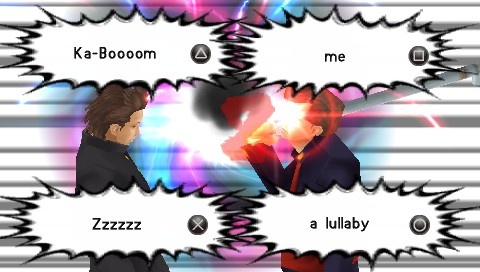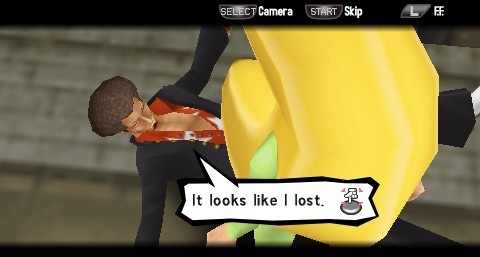High school can be a difficult time. On top of things like homework, attempts at romance, and just trying to sort out who you are and what you want to do with your life, you also need to prove that you're the best fighter in the country. It's a lot for any young person to deal with. Kenka Bancho tells the tale of one young man's struggle to rise to the top of Japan's bancho ranks. The brawling at the game's core is unrefined, but the characters make this zany, distinctly Japanese adventure an entertaining one. You don't need to know your shibui from your shabai to enjoy Kenka Bancho--these tough-talkin' high school street fighters are cool in any language.

Kenka Bancho takes place during a senior class trip to the fictional city of Kyouto. (Any similarities between the fictional Kyouto and the actual Kyoto are, of course, purely coincidental.) Your character is a rebel with a cause--becoming the coolest, toughest fighter in all of Japan. Upon arriving in Kyouto, he wastes no time in proving himself to be the greatest fighter, or the bancho, of his home prefecture. Conveniently, the banchos of every territory across Japan are gathered in Kyouto throughout the week, giving you a chance to beat every sorry, snot-nosed one of them and take your rightful place at the top.
Part of the fun of Kenka Bancho is in deciding how to spend your time. Your school has scheduled morning trips to castles, temples, and shrines, which you can choose either to go on or to blow off in favor of prowling the streets for rival banchos. The class trips are always eventful and usually give you a chance to break someone's face while defending a lady's honor, perhaps improving your chances for romance. You're always free to do as you please in the afternoon, and in addition to the 46 banchos hanging out in Kyouto, the streets are crawling with run-of-the-mill tough guys and gals you can clobber. You're rewarded for your victories with experience points that strengthen your attributes, and you'll also get money and helpful restorative items from defeated thugs. Most useful of all are the itineraries they drop for their school's trip, which you can use to track down that school's bancho. The goal of defeating every bancho is one you can pursue as aggressively or as calmly as you please, and regardless of how you choose to spend your time, you'll come away from your class trip with some fond memories.
The actual brawling in this third-person, open-world brawler isn’t great. In typical brawler fashion, you can tap buttons to punch and kick, and string your attacks together for combos. You can also hold down attack buttons for a few seconds to put more power behind your attacks, and press two buttons at once to perform a powerful special move. Frustratingly, even when locked on to an opponent, it’s all too common for your punches and kicks to hit empty air. Also, your movements are slow and stiff, and there's an odd delay between the time you press a button and the time your character carries out an attack that keeps the action from feeling as immediate and intense as it should. Still, there's a satisfying sense of power behind your attacks, and the fisticuffs are kept fresh by the constant unlocking of new moves. You'll frequently learn new variations on the punches and kicks that are the backbone of your fighting style. And from each bancho you defeat, you acquire a stylish and powerful new move, called a local specialty. In your hotel room or while waiting for a bus, you can customize your fighting style with these new moves to make yourself an even badder bancho. And as an added reward, the banchos you defeat become your peons, ready at your behest to follow you into battle. They're not brilliant fighters, but just having someone else around to absorb some of your opponent's blows is a great help during some tougher fights.

But there's more to being a bancho than fighting, and it's not the unremarkable brawling that makes Kenka Bancho memorable. It's the sheer determination of every bancho. There's a code you need to abide by to be a true bancho, and part of that code is to not attack anyone without warning. The prelude to a fight is often more entertaining than the fight itself. To initiate combat the bancho way, you must first stare at your would-be opponent with great intensity. Your menchi stare, as it's called, is so fierce that beams shoot out of your eyes. Some targets will bow in submission to your obvious superiority. Others will simply run away in fear. If your marks think they have what it takes to stand up to you, they'll cut a menchi stare right back, leading to the next phase of pre-combat intimidation: smashtalk. In smashtalk, a phrase appears on the screen briefly, something savage like "I will end you!" or "Shove it, you pile of crap!" You then need to re-create that phrase by quickly hitting the right buttons to select parts of the sentence from among several sentence fragments that are briefly displayed. Do it successfully and you'll land the first blow. Slip up and you'll say something a bit less intimidating, like "Eggs are giving a pedicure!" and you'll get a mouthful of knuckle sandwich. You may find yourself wishing you had more freedom to craft your own fearsome taunts from the supplied sentence fragments, but these two phases to initiating combat are fun, humorous, and full of personality.
Also dripping with personality are the banchos you encounter. Some of them come across as legitimately cool, while others are way out of their league and only make bigger fools of themselves by trying to talk tough and look good. And no matter what your personal concept of cool may be, you can customize your character so that he embodies it. Whether you want to sport a leather jacket and a comically huge pompadour, a Mohawk and a trench coat, or anything in between, the boutiques and barbershops of Kyouto will offer a style that suits you. Or you can throw every conceivable definition of cool out the window and deck out your hero in something truly absurd. Story cutscenes reflect your character's clothing and hairstyle, and seeing him talk trash while wearing a giant banana suit is an endless source of amusement. No matter what you're wearing, the game is frequently hilarious. Atlus has done an excellent job on localization, making the dialogue sharp and funny and lacing it with the occasional pop culture reference, while keeping its Japanese flavor intact.
Unfortunately, Kyouto itself doesn't have much character. Rather than being a vibrant whole, the city is divided up into a number of small sections, each of which is rather featureless and sterile. People pop in to the environment only when very close to you, and details like cars rigidly driving along roads don't do enough to make the neighborhoods feel alive. Character models look decent, though, and the colorful effects that accompany your menchi stare and your local specialty moves elevate the brawling action above the mundane visuals of the rest of the game. The sound is unexceptional, with appropriate but forgettable tunes accompanying the action and sound effects that lack the passion and intensity of the game's characters.

In addition to the story mode, there's an option called Night Out, which lets you take to the streets at night to do nothing but brawl and earn experience, and it can be played with a friend via ad hoc. But the brawling isn't the highlight of the main mode, and it's even less interesting when removed from it. A single play-through of Kenka Bancho takes roughly eight hours, and you can carry over your character, items, money, and any itineraries you've found to subsequent play-throughs. With so many banchos to fight and plenty of secrets to discover throughout Kyouto, there's lots of replay value here. As a brawler, it leaves something to be desired, but in spite of its flaws, this is a senior trip you won't soon forget.